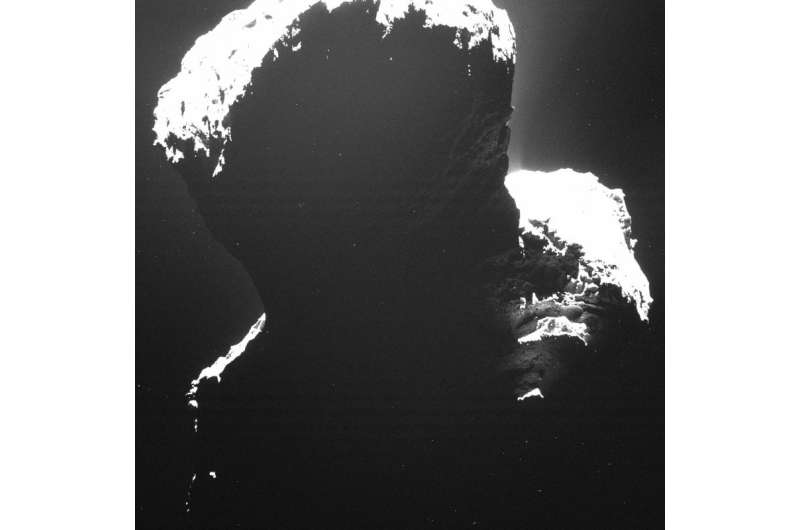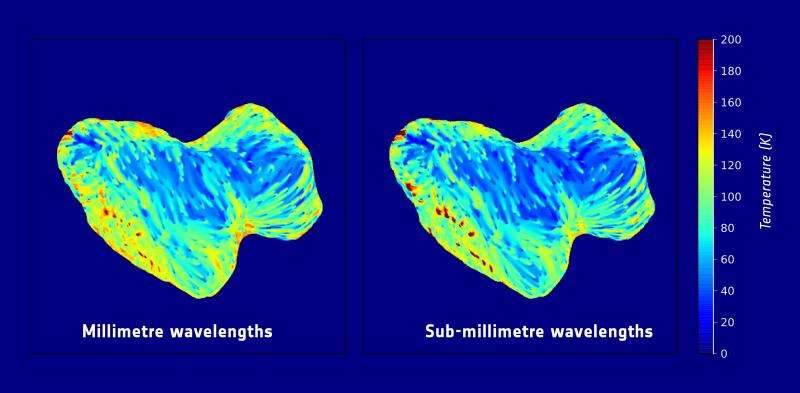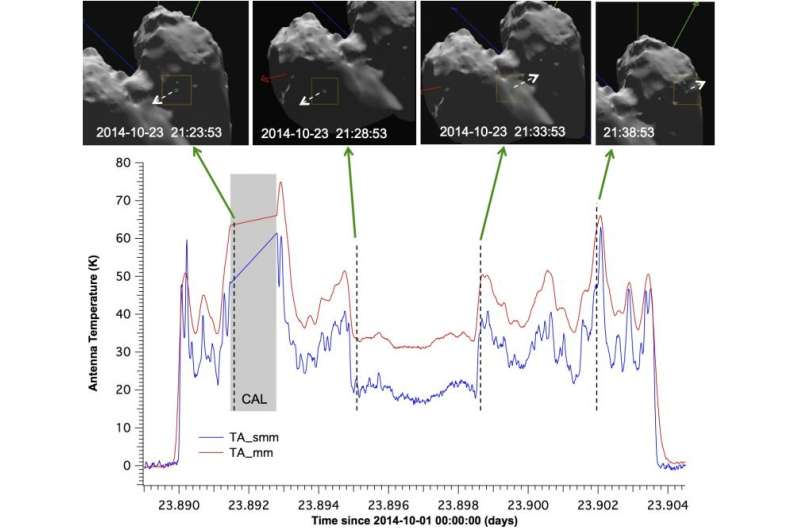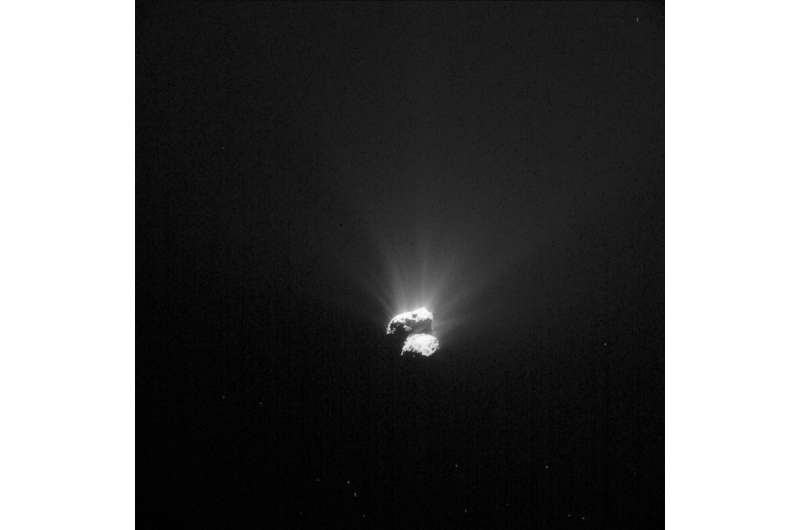Rosetta's first peek at the comet's south pole

Using the Microwave Instrument for the Rosetta Orbiter (MIRO), scientists have studied the comet's southern polar regions at the end of their long winter season. The data suggest that these dark, cold regions host ice within the first few tens of centimetres below the surface in much larger amounts than elsewhere on the comet.
Since its arrival at Comet 67P/Churyumov-Gerasimenko, Rosetta has been surveying the surface and the environment of this curiously-shaped body. But for a long time, a portion of the nucleus – the dark, cold regions around the comet's south pole – remained inaccessible to almost all instruments on the spacecraft.
Due to a combination of its double-lobed shape and the inclination of its rotation axis, Rosetta's comet has a very peculiar seasonal pattern over its 6.5 year-long orbit. Seasons are distributed very unevenly between the two hemispheres, each of which comprises parts of both comet lobes and of the 'neck'.
For most of the comet's orbit, the northern hemisphere experiences a very long summer, lasting over 5.5 years, and the southern hemisphere undergoes a long, dark and cold winter. However, a few months before the comet reaches perihelion – the closest point to the Sun along its orbit – the situation changes, and the southern hemisphere transitions to a brief and very hot summer.
When Rosetta arrived at 67P/C-G in August 2014, the comet was still experiencing its long summer in the northern hemisphere and regions on the southern hemisphere received very little sunlight. Moreover, a large part of this hemisphere, close to the comet's south pole, was in polar night and had been in total darkness for almost five years.
With no direct illumination from the Sun, these regions could not be imaged with Rosetta's OSIRIS science camera. In addition, their low temperatures – ranging between 25 and 50 degrees above absolute zero – did not allow observations with VIRTIS, the Visible, InfraRed and Thermal Imaging Spectrometer, either.
For the first several months after Rosetta's arrival at the comet, only one instrument on the spacecraft could observe and characterise the cold southern pole of 67P/C-G: the Microwave Instrument for the Rosetta Orbiter (MIRO).
In a paper accepted for publication in the journal Astronomy and Astrophysics, scientists report on the data collected by MIRO over these regions between August and October 2014.

"We observed the 'dark side' of the comet with MIRO on many occasions after Rosetta's arrival at 67P/C-G, and these unique data are telling us something very intriguing about the material just below its surface," explains Mathieu Choukroun from NASA's Jet Propulsion Laboratory, lead author of the study.
Observing the comet's southern polar regions, Choukroun and colleagues found significant differences between the data collected with MIRO's millimetre and sub-millimetre wavelength channels. These differences might point to the presence of large amounts of ice within the first few tens of centimetres below the surface of these regions.
"Surprisingly, the thermal and electrical properties around the comet's south pole are quite different to what is found elsewhere on the nucleus. It appears that either the surface material or the material that lies down to a few tens of centimetres below it is extremely transparent at the MIRO wavelengths of 0.5 and 1.6 mm, and could consist mostly of water ice or carbon-dioxide ice," he adds.
The difference between the surface and sub-surface composition of this part of the nucleus and that found elsewhere might originate in the comet's peculiar cycle of seasons. One of the possible explanations is that water and other gases that were released during the comet's previous perihelion, when the southern hemisphere was the most illuminated portion of the nucleus, condensed again and precipitated on the surface after the season changed and the southern hemisphere plunged again into its long and cold winter.
These are, however, preliminary results, because the analysis depends on the detailed shape of the nucleus, and at the time the measurements were made the shape of the dark, southern polar region was not known to great accuracy.
"We plan to revisit the MIRO data using an updated version of the digital shape model, to verify these early results and refine the interpretation of the measurements," adds Choukroun.
Besides, Rosetta scientists will be testing these and other possible scenarios using data that were collected in the subsequent months, leading to the comet's perihelion, which took place on 13 August 2015, and beyond.

In May 2015, the seasons changed on 67P/C-G and the brief, hot southern summer, which will last until early 2016, began. As the formerly dark southern polar regions started to receive more sunlight, it has been possible to observe them with other instruments on Rosetta, and the combination of all data might eventually disclose the origin of their curious composition.
"In the past few months, Rosetta has flown over the southern polar regions on several occasions, starting to collect data from this part of the comet after summer began there," explains Matt Taylor, ESA Rosetta project scientist.
"At the beginning of the southern summer, we had a paucity of observations in these regions as Rosetta's trajectory focussed on the northern hemisphere due to ongoing communication with the lander, Philae. However, closer to perihelion we were able to begin observing the south.
"Rosetta is currently on an excursion out to 1500 km from the nucleus to study the comet's environment at large, but it will soon come closer to the comet, focussing on full orbits to compare the northern and southern hemispheres, as well as some slower passes in the south to maximise our observations there. In addition, as activity will start to wane later this year, we hope to get closer to the nucleus and gain higher resolution observations of the surface."

Mark Hofstadter, MIRO Principal Investigator at NASA's Jet Propulsion Laboratory, describes the result as "a great example of how the scientific process unfolds as Rosetta is studying the evolution of this comet up close."
"First, we observed these dark regions with MIRO, the only instrument able to do so at the time, and we tried to interpret these unique data. Now, as these regions became warmer and brighter around perihelion, we can observe them with other instruments, too," he adds.
"We hope that, by combining data from all these instruments, we will be able to confirm whether or not the south pole had a different composition and whether or not it is changing seasonally."
More information: "Dark side of 67P/Churyumov-Gerasimenko in Aug-Oct 2014. MIRO/Rosetta continuum observations of polar night in the southern regions" A&A, 25 March 2015 / Accepted: 24 September 2015 DOI: dx.doi.org/10.1051/0004-6361/201526181
Journal information: Astronomy & Astrophysics
Provided by European Space Agency





















